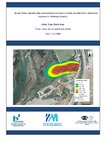Modelling flow and contaminant transport in Sardas site affected by lindane from Inquinosa in Sabiñánigo (Huesca)
Title
Modelling flow and contaminant transport in Sardas site affected by lindane from Inquinosa in Sabiñánigo (Huesca)Author(s)
Date
2020Description
Traballo fin de mestrado (UDC.ETSECCP). Enxeñaría da Auga. Curso 2020/2021Abstract
[Abstract:] The INQUINOSA lindane factory in Sabiñánigo (Spain) operated since 1975 until 1992. Dust and liquid wastes from the lindane production were disposed at the Sardas landfill. The Sardas landfill lies over the Larrés marls without waterproofing. It occupies an area of 4 ha and is located less than 1 km to the East of the downtown. The conceptual model of the site was tested by EMGRISA (2014) with a groundwater flow model performed with MODFLOW (Harbaugh et al., 2005). This master’s thesis presents 2D steady-state and transient numerical models of groundwater flow and contaminant transport of the Sardas site, which have been performed with the finite-element computer code CORE2D V5. First, a 2D model along a vertical profile in E-W direction, which runs along the thalveg of the original gully, has been constructed to test the conceptual hydrogeological model of the site. The numerical model confirms the conceptual model. The average water inflow to the Sardas landfill ranges from 20 m3/d to 30 m3/d. Most of the inflow comes from the infiltration of the surface runoff of the ravine located in the header of the landfill and the infiltration of surface and subsurface runoff along the perimeter ditches. The landfill outflows take place by pumping wells, underneath and around the front slurry-wall. The subsurface discharge of the landfill percolates into the Gállego alluvial aquifer. The 2D horizontal numerical models of groundwater flow through the gravels of alluvial aquifer confirm the strong influence of the daily periodic fluctuations of the water level of the Sabiñánigo reservoir and the Gállego river on groundwater hydraulic heads. The numerical models of the pumping and tracer tests showed the spatial heterogeneities and anisotropy of the hydraulic conductivity of the gravels and allowed the estimation of the porosity and dispersivity the gravels. The leachates from the landfill discharge into the reservoir through the silting sediments, which deposited at the bottom of the Sabiñánigo reservoir. The vertical hydraulic conductivity and the distribution coefficient of HCH of these sediments play a major role on the discharge of HCH to the reservoir.
Keywords
Landfill
Lindane (HCH)
Groundwater flow
Contaminant transport
Numerical models
Lindane (HCH)
Groundwater flow
Contaminant transport
Numerical models






